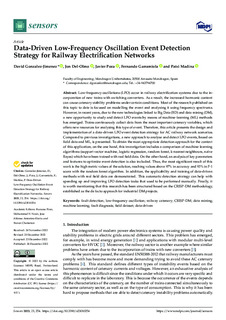Título
Data‐Driven Low‐Frequency Oscillation Event Detection Strategy for Railway Electrification NetworksFecha de publicación
2023Grupo de investigación
Accionamientos aplicados a la tracción y a la generación de energía eléctricaVersión
Version publicadaTipo de documento
ArtículoArtículoIdioma
InglésDerechos
© 2022 The AuthorsAcceso
Acceso abiertoVersión de la editorial
https://doi.org/10.3390/s23010254Publicado en
Sensors Vol. 23. N. 1. 254Editorial
MDPIPalabras clave
fault detection
low-frequency oscillation
railway catenary
CRISP-DM ... [+]
low-frequency oscillation
railway catenary
CRISP-DM ... [+]
fault detection
low-frequency oscillation
railway catenary
CRISP-DM
Data mining
machine learning
Fault diagnosis
field dataset
data-driven [-]
low-frequency oscillation
railway catenary
CRISP-DM
Data mining
machine learning
Fault diagnosis
field dataset
data-driven [-]
Resumen
Low-frequency oscillations (LFO) occur in railway electrification systems due to the incorporation of new trains with switching converters. As a result, the increased harmonic content can cause catena ... [+]
Low-frequency oscillations (LFO) occur in railway electrification systems due to the incorporation of new trains with switching converters. As a result, the increased harmonic content can cause catenary stability problems under certain conditions. Most of the research published on this topic to date is focused on modelling the event and analysing it using frequency spectrums. However, in recent years, due to the new technologies linked to Big Data (BD) and data mining (DM), a new opportunity to study and detect LFO events by means of machine-learning (ML) methods has emerged. Trains continuously collect data from the most important catenary variables, which offers new resources for analysing this type of event. Therefore, this article presents the design and implementation of a data-driven LFO event detection strategy for AC railway network scenarios. Compared to previous investigations, a new approach to analyse and detect LFO events, based on field data and ML, is presented. To obtain the most appropriate detection approach for the context of this application, on the one hand, this investigation includes a comparison of machine-learning algorithms (support vector machine, logistic regression, random forest, k-nearest neighbours, naïve Bayes) which have been trained with real field data. On the other hand, an analysis of key parameters and features to optimize event detection is also included. Thus, the most significant result of this work is the high metric values of the solution, reaching values above 97% in accuracy and 93% in F-1 score with the random forest algorithm. In addition, the applicability and training of data-driven methods with real field data are demonstrated. This automatic detection strategy can help with speeding up and improving LFO detection tasks that used to be performed manually. Finally, it is worth mentioning that this research has been structured based on the CRISP-DM methodology, established as the de facto approach for industrial DM projects. [-]
Colecciones
- Artículos - Ingeniería [757]
El ítem tiene asociados los siguientes ficheros de licencia:






















